| Origin | Third to fifth ribs & the fascia overlying these intercostal spaces |
| Insertion | Coracoid process of the scapula |
| Action | Depression of the scapula Protraction of the scapula Elevation of ribs |
| Nerve | Medial pectoral nerve (C8 & T1) Lateral pectoral nerve (C5, C6, & C7) |
| Artery | Pectoral branch of the thoracoacromial artery |
Location & Overview
The pectoralis minor muscle is a small and somewhat triangular shaped muscle which is sometimes referred to as the “pec minor”. It is located in the superior and anterior part of the chest and lies beneath the larger pectoralis major muscle, hence its designation as the ‘minor’ component of the pectorals, or ‘pecs’. Given its position deep to the pectoralis major and deltoid, it’s not visible externally. The pectoralis minor is nestled close to the anterior chest wall, situating it deeper than many of the other muscles in this region [1] [2] [3].
The pec minor forms part of the anterior wall of the axilla. The axilla is also known as the armpit. This anatomical position makes it an important muscle when it comes to the movement and stability of the shoulder joint [4] [5] [6].

Here we can see the pectoralis minor muscle from an anterior view.
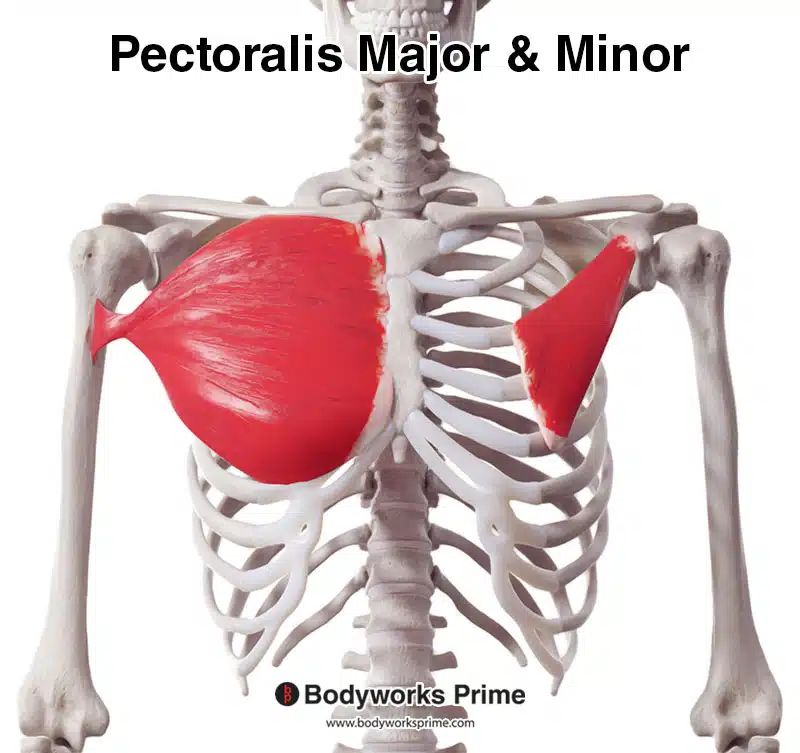
Here we can see the pectoralis major and minor muscles. The pectoralis minor is deep to the pectoralis major.

Here we can see the pectoralis minor muscle from an anterolateral view.

Here we can see the pectoralis minor muscle from a lateral view.
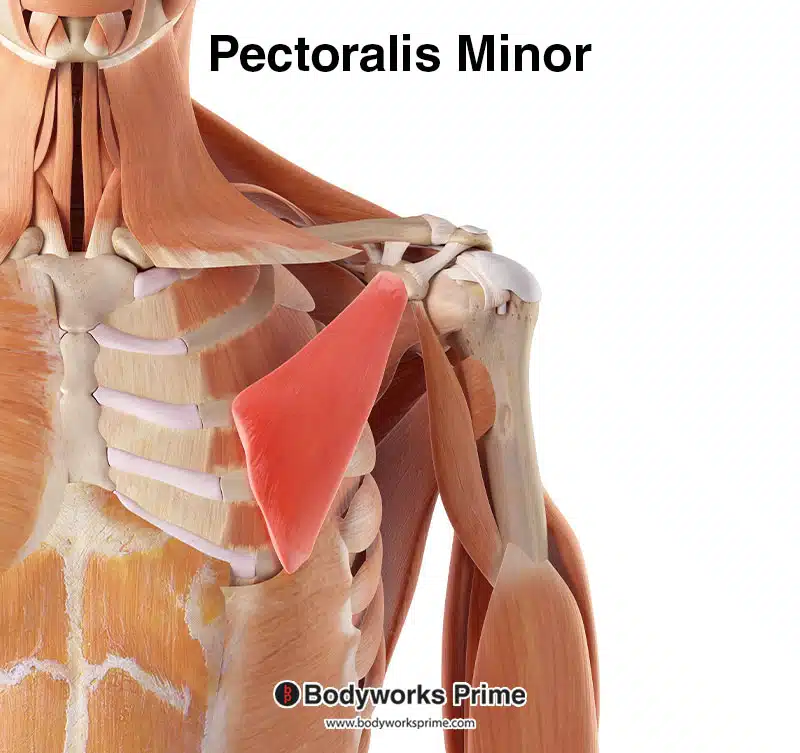
Pictured here we can see the pectoralis minor amongst the other muscles of the upper body. Superficial muscles such as the pectoralis major and deltoid have been removed to reveal the pectoralis minor’s location.

Pictured here we can see the pectoralis major amongst the other muscles of the body. The pectoralis minor is deep to the pectoralis major. Therefore, we are unable to see the pectoralis minor in this image.
Origin & Insertion
The pectoralis minor muscle takes its origin from the anterior surface of the third, fourth, and fifth ribs, specifically from the margins adjacent to their costochondral junctions. These are the points where the bony part of the rib meets the cartilage that connects the ribs to the breastbone, or sternum. Additionally, the deep fascia overlying these intercostal spaces – the spaces between the ribs – also contributes to the origin of the pectoralis minor. This muscular origin region resides just lateral to the sternum, the long flat bone located in the centre of the chest [7] [8] [9].
From this origin, the fibers of the pectoralis minor ascend superolaterally, angling upward and sideways towards the shoulder. The fibers eventually converge to form a flat tendon that inserts onto the coracoid process of the scapula. The coracoid process is a small hook-like structure that projects anteriorly from the superior aspect of the scapula. The pectoralis minor attaches to the medial border and superior surface of the coracoid process [10] [11] [12].
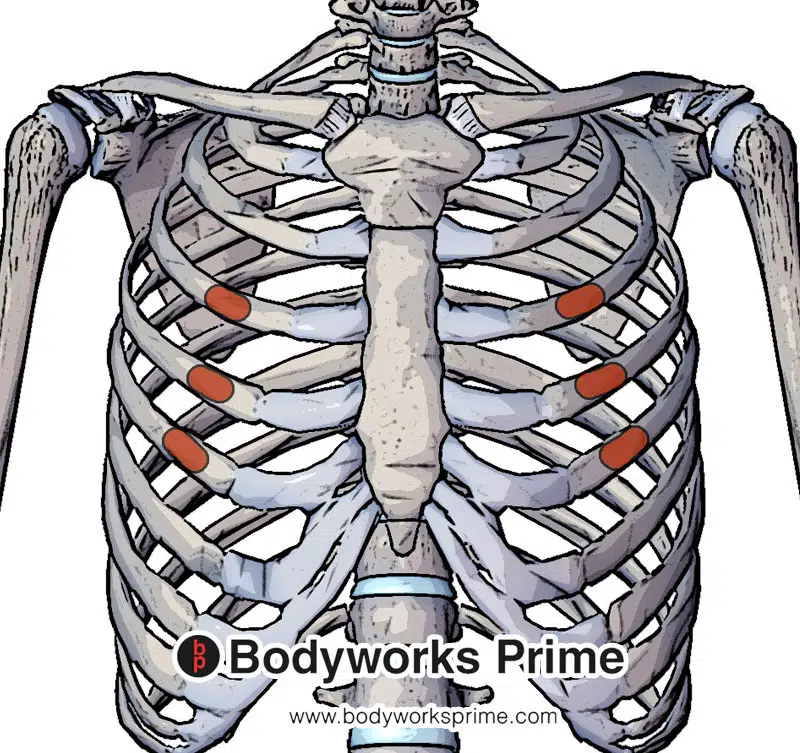
Pictured here we can see the pectoralis minor’s origin at the third to fifth ribs (highlighted in red).

Pictured here we can see the pectoralis minor’s insertion at the Coracoid process of the scapula. Specifically, the medial border and superior surface (highlighted in blue).
Actions
The pectoralis minor primarily contributes to movements of the shoulder girdle and it also aids in the process of respiration as a secondary action. One of its primary shoulder functions is to depress the scapula, an action which is seen when one actively lowers their scapula/shoulder, moving it downward. In this motion, the pectoralis minor pulls the coracoid process of the scapula downward, causing shoulder to move downwards too [13] [14].
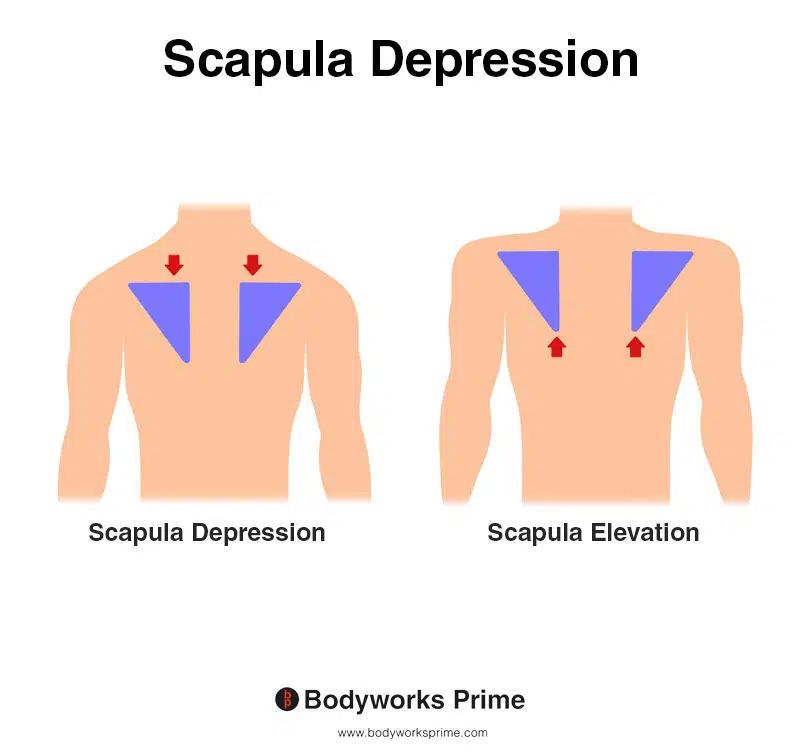
This image shows scapula depression, where the shoulder blade moves downward, drawing the shoulder joint inferiorly. This movement happens when lowering a weight from an overhead position or when actively pushing the shoulders down. The opposite of scapula depression is scapula elevation.
Another primary action of the pectoralis minor it to contribute to the protraction of the scapula. During protraction, the muscle acts to draw the scapula laterally and forward along the chest wall, towards the front of the body. This motion can be visualised by imagining reaching forward to push an object, such as when pushing open a door [15] [16].
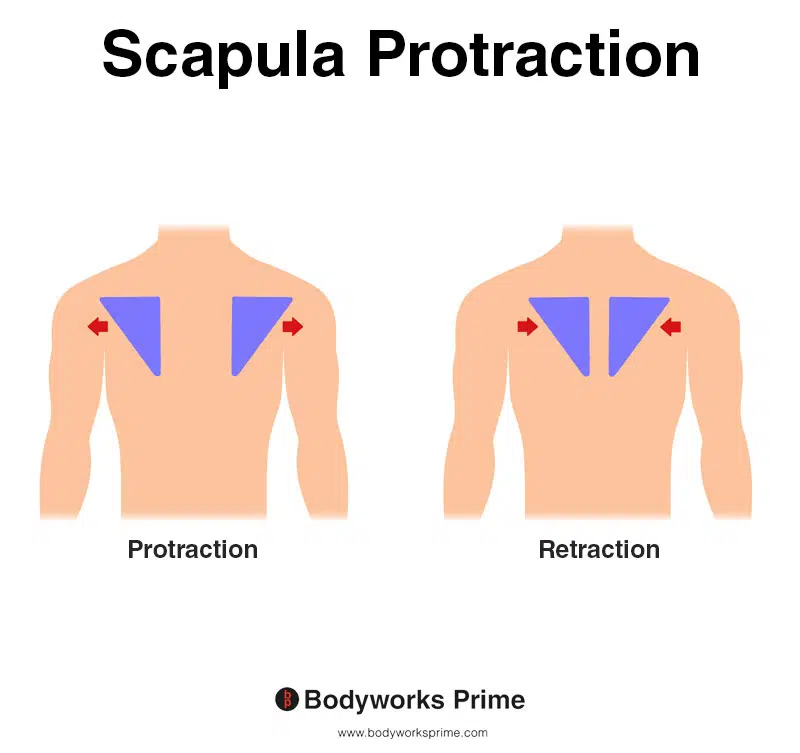
This image shows scapula protraction, a motion where the shoulder blade moves laterally and anteriorly along the rib cage (toward the front of the body). This movement occurs during actions such as reaching forward or pushing an object. The opposite of scapula protraction is scapula retraction.
In addition to its role in shoulder movements, the pectoralis minor also serves as an accessory muscle of respiration [17]. This occurs when other muscles hold the scapula in place, allowing the pectoralis minor to act on the ribs. During the process of inspiration, especially deep or forced inspiration, the pectoralis minor can lift the third, fourth, and fifth ribs. This action assists other muscles in expanding the chest cavity, which then allows for a greater volume of air to enter the lungs [9][10].

This image shows the process of inspiration on the left, where the chest expands as the lungs fill with air. This movement is particularly pronounced during deep breathing or activities requiring increased oxygen intake, such as exercise. The opposite of inspiration is expiration. On the right is the process of expiration, where the chest contracts to expel air from the lungs. The pectoralis minor assists with inspiration (breathing in).
Beyond these specific actions of scapula depression, scapula protraction, and elevation of ribs, the pectoralis minor also plays a role in stabilising the scapula too [18].
Innervation
The pectoralis minor muscle is innervated by the medial pectoral nerve and the lateral pectoral nerve [19] [20].
The medial pectoral nerve originates from the brachial plexus and it is an offshoot of the medial cord. It carries impulses from the anterior rami of spinal nerves C8 and T1 [21].
The lateral pectoral nerve also contributes to the innervation of the pectoralis minor, albeit to a lesser extent. This nerve branches from the lateral cord of the brachial plexus, carrying impulses from the anterior rami of spinal nerves C5, C6, and C7 [22].
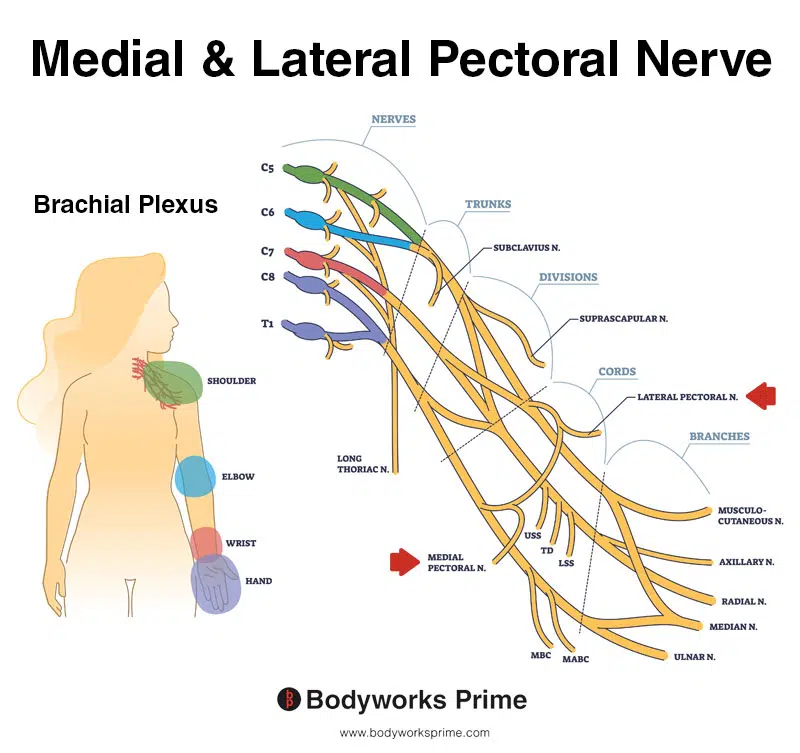
Pictured here you can see the medial and lateral pectoral nerves alongside the brachial plexus. The pectoralis minor muscle is innervated by the medial pectoral nerve and the lateral pectoral nerve.
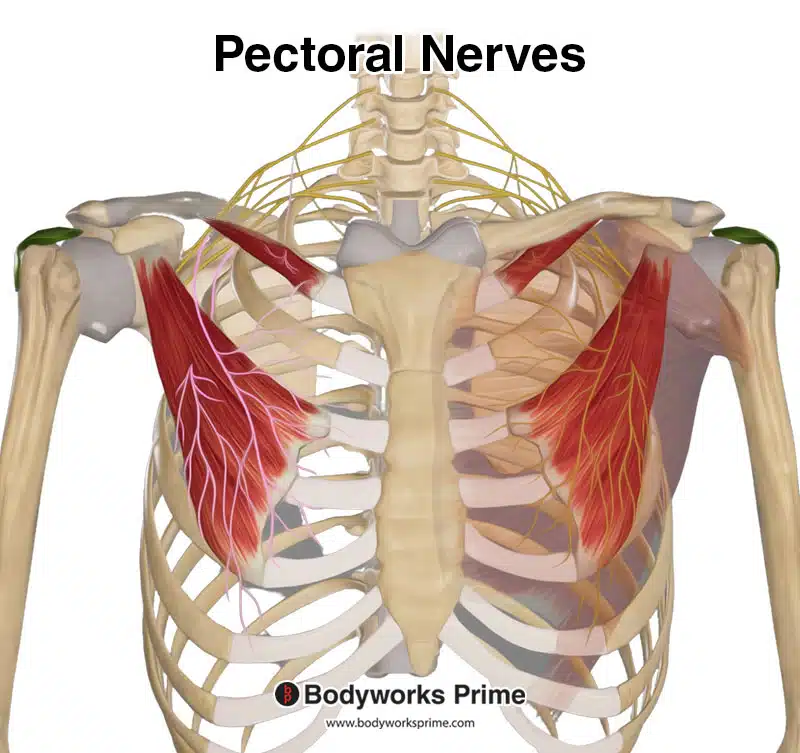
Pictured here you can medial and lateral pectoral nerves which innervate both the pectoralis minor and major.
Blood Supply
The pectoralis minor muscle’s blood supply is primarily from the thoracoacromial artery which runs along the upper chest [23] [24]. The thoracoacromial artery originates from the second part of the axillary artery. The axillary artery is also known as the acromiothoracic artery and gives off several branches, including the acromial, deltoid, clavicular, and pectoral branches [25].
Want some flashcards to help you remember this information? Then click the link below:
Pectoralis Minor Flashcards
Support Bodyworks Prime
Running a website and YouTube channel can be expensive. Your donation helps support the creation of more content for my website and YouTube channel. All donation proceeds go towards covering expenses only. Every contribution, big or small, makes a difference!
References
| ↑1, ↑4 | Moore KL, Agur AMR, Dalley AF. Clinically Oriented Anatomy. 8th ed. Philadelphia: Lippincot Williams & Wilkins; 2017. |
|---|---|
| ↑2, ↑5, ↑7, ↑10, ↑13, ↑15, ↑19 | Tang A, Bordoni B. Anatomy, Thorax, Muscles. [Updated 2022 Jul 25]. In: StatPearls [Internet]. Treasure Island (FL): StatPearls Publishing; 2023 Jan-. Available from: https://www.ncbi.nlm.nih.gov/books/NBK538321/ |
| ↑3, ↑6, ↑8, ↑11, ↑14, ↑16, ↑18, ↑20 | Baig MA, Bordoni B. Anatomy, Shoulder and Upper Limb, Pectoral Muscles. [Updated 2022 Aug 30]. In: StatPearls [Internet]. Treasure Island (FL): StatPearls Publishing; 2023 Jan-. Available from: https://www.ncbi.nlm.nih.gov/books/NBK545241/ |
| ↑9, ↑12, ↑21, ↑22, ↑25 | Standring S. (2015). Gray’s Anatomy: The Anatomical Basis of Clinical Practice, 41st Edn. Amsterdam: Elsevier. |
| ↑17 | Donley ER, Holme MR, Loyd JW. StatPearls [Internet]. StatPearls Publishing; Treasure Island (FL): Oct 2, 2022. Anatomy, Thorax, Wall Movements. |
| ↑23 | Sanchez ER, Sanchez R, Moliver C. Anatomic relationship of the pectoralis major and minor muscles: a cadaveric study. Aesthet Surg J. 2014 Feb;34(2):258-63. |
| ↑24 | Solari F, Burns B. Anatomy, Thorax, Pectoralis Major Major. [Updated 2022 Jul 25]. In: StatPearls [Internet]. Treasure Island (FL): StatPearls Publishing; 2023 Jan-. Available from: https://www.ncbi.nlm.nih.gov/books/NBK525991/ |










